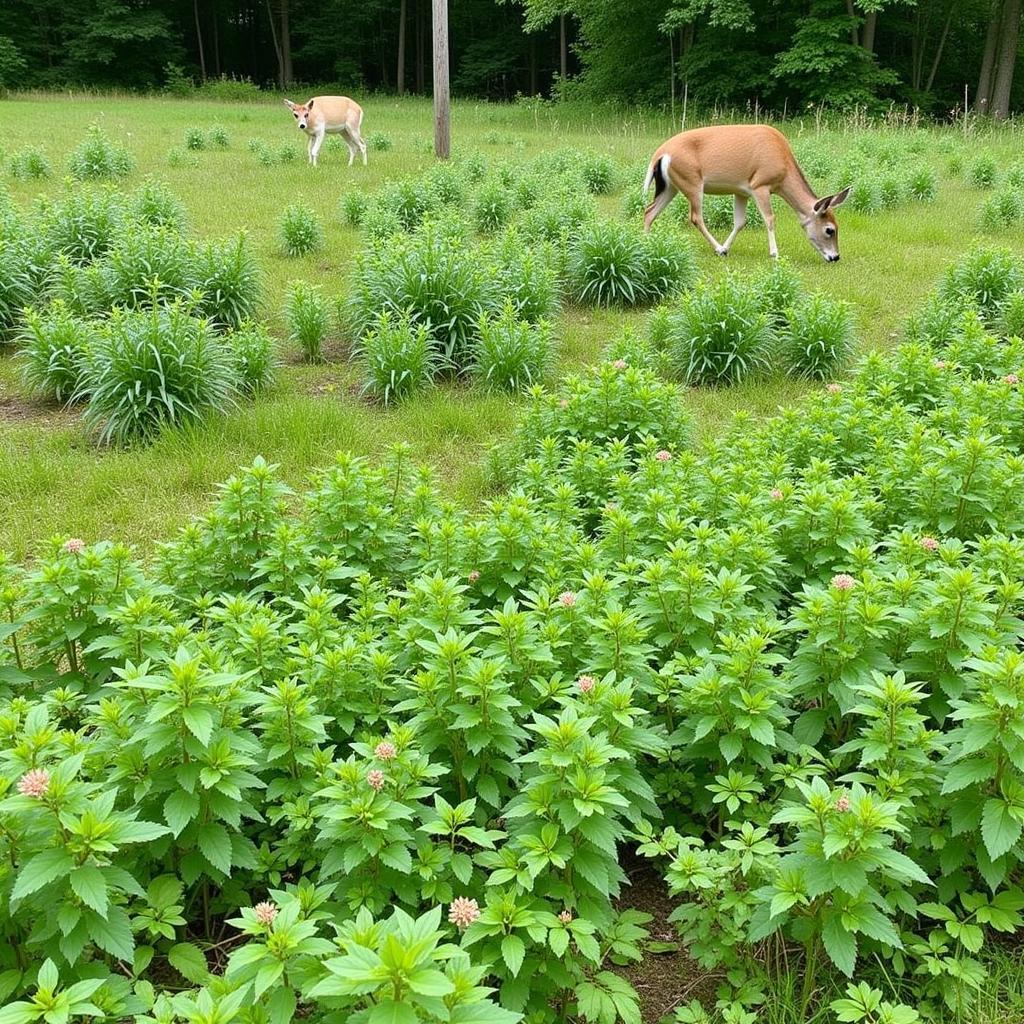Deer food plots are an essential part of managing a healthy deer herd, especially during the spring and summer months when natural forage options may be limited. A well-planned food plot can provide deer with the essential nutrients they need to thrive, leading to healthier fawns, larger antlers, and a more robust population overall.
 Deer grazing in a lush spring food plot
Deer grazing in a lush spring food plot
Understanding Deer Nutritional Needs in Spring and Summer
As deer transition from the lean winter months into spring, their nutritional demands change significantly. Fawns are growing rapidly, does are lactating, and bucks are beginning to grow antlers. All of this requires a diet rich in protein, energy, and essential minerals. During the summer, these nutritional needs remain high as deer continue to recover from winter and prepare for the fall breeding season.
Choosing the Right Food Plot Seed
Selecting the right deer plot food seed is crucial for a successful food plot. In spring and summer, deer are drawn to highly palatable and digestible plants that offer the nutrients they need. Consider these popular options:
- Soybeans: A warm-season legume, soybeans provide a high protein content that’s essential for antler growth and fawn development.
- Cowpeas: Similar to soybeans, cowpeas are another excellent source of protein and can tolerate poor soil conditions.
- Lablab: This warm-season legume offers high yields and is very palatable to deer, making it a great choice for attracting and holding deer on your property.
- Clovers: A cool-season legume, clovers can be planted in early spring or late summer and provide a good source of protein throughout much of the year.
Planting and Maintaining Your Food Plot
Proper planting and maintenance techniques are crucial for maximizing the success of your food plot:
- Soil Testing: Before planting, conduct a soil test to determine the pH and nutrient levels. This will help you determine the appropriate fertilizer and lime requirements for your specific plot.
- Plot Preparation: Clear the area of existing vegetation and till the soil to create a loose seedbed.
- Planting: Follow the recommended seeding rates and planting depths for your chosen seed varieties.
- Fertilization and Weed Control: Apply fertilizer based on your soil test results and implement a weed control strategy to minimize competition for your desired plants.
- Monitoring: Regularly inspect your food plot for signs of pests, diseases, or nutrient deficiencies and take corrective action as needed.
Attracting Deer to Your Food Plot
Creating a successful food plot goes beyond simply planting the right seeds. Consider these additional tips for attracting deer to your property:
- Location, Location, Location: Choose a location that provides a mix of open feeding areas and nearby cover, such as trees or brush, where deer feel safe.
- Water Source: Ensure a reliable water source is available near your food plot.
- Mineral Supplements: Consider providing a mineral supplement to further enhance the nutritional value of your food plot.
“A well-maintained food plot is like a magnet for deer,” says wildlife biologist Sarah Miller. “By providing the right food sources, you can significantly improve the health and vitality of your local deer herd.”
FAQs about Deer Food Plots for Spring and Summer
Q: When is the best time to plant a spring food plot?
A: The ideal planting time for spring food plots varies depending on your location and climate. Generally, aim to plant cool-season varieties, like clovers, as soon as the ground can be worked in late winter or early spring. Warm-season varieties, like soybeans and lablab, should be planted after the risk of frost has passed.
Q: How large should my food plot be?
A: The ideal size of your food plot depends on the size of your property and the local deer population. As a general rule, aim for a food plot that’s at least 1/4 acre in size.
Q: What are some common mistakes to avoid when creating a food plot?
A: Some common mistakes include improper soil preparation, planting the wrong seed varieties for your region, neglecting weed control, and not providing a reliable water source.
Conclusion
Creating and maintaining Deer Food Plots For Spring And Summer is an investment in the health and sustainability of your local deer herd. By understanding their nutritional needs, selecting the right food plot seed, and implementing proper planting and maintenance techniques, you can help ensure your deer population thrives throughout the year. Remember to explore our range of food plot implements for all your food plot needs.
For more information on hunting food plots and creating the ultimate food plot strategy, check out our other helpful articles. Looking for the perfect seed blend to grow a monster buck? Explore our selection of monster buck food plot seed. And for those looking for powerful and efficient equipment, our food plot tiller options might be just what you need.
Need assistance with your deer food plot plans? Contact us at Phone Number: 02437655121, Email: [email protected] or visit us at 3PGH+8R9, ĐT70A, thôn Trung, Bắc Từ Liêm, Hà Nội, Việt Nam. Our dedicated customer support team is available 24/7 to assist you.